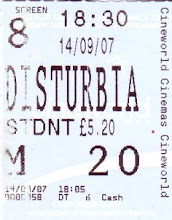Claude decided that they were a good way to understand the production of meaning within a narrative - and that it made it easier for the audience to understand and empathise.
A very common example is Good vs. Evil
Each genre also has their own binary opposites - for example Westerns often have Sheriff vs. Outlaw
Action/Enigma Codes - Roland Barthes
Action + Enigma codes are narrative codes which films are made up of - they are the 2 ways in which suspense is created.
Action Codes refer to actions - events leading to other events, the suspense is created by the audience wondering what the next event will be.
For example, in Disturbia when the villain realises Kale is watching him, we wonder what is going to do.
Enigma codes raise questions - the audience asks the reason for an event.
For example, in Disturbia we wonder why was there a blood smear on the window?
Narrative Structure - Tzvetan Todorov
1.) The fictional world begins with equilibrium
2.) Then it suffers a disruption
3.) A new equilibrium is produced
The 5 stages the narrative can go through is circular (not linear). The plot/narrative is driven by attempts to restore the equilibrium.
1.) Equilibrium
2.) Disruption - event
3.) Recognition of disorder
4.) Attempt to repair
5.) New equilibrium is established
However, the final equilibrium is never the same as the first, through the disruption to characters or situations events happen which cannot be undone - for example a murder. And the disruption which occurs is always out of the ordinary frame work of the fictional world
Folk Tales Character Types - Vladimir Propp
He identified 8 common roles:
- The Villain
- The Hero - a character who seeks something - he is motivated by a lack of something (money/love). Sometimes not heroic in the conventional way - can be male/female courageous/cowardly
- The Donor - provides an object/information of value
- The helper - a sidekick aiding the hero
- The princess - hero's reward, an object of the villain's schemes. Princess could be male
- Her father - who rewards the hero
- The Dispatcher - sending the hero on his way
- The false hero
They become more interesting/noticeable when the rules are broken - they are only really noticed when they are broken. For example in psycho the character perceived to be the hero is killed in the first half an hour.
I'm planning to watch a film and try to apply these theories because in order to potentially break them for my thriller i will have to understand them. I am considering doing this to create more of a twist on convention and essentially more of 'a thrill' to the audience

No comments:
Post a Comment